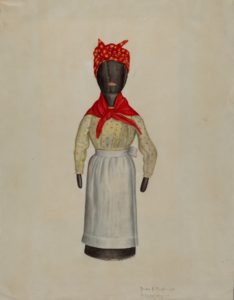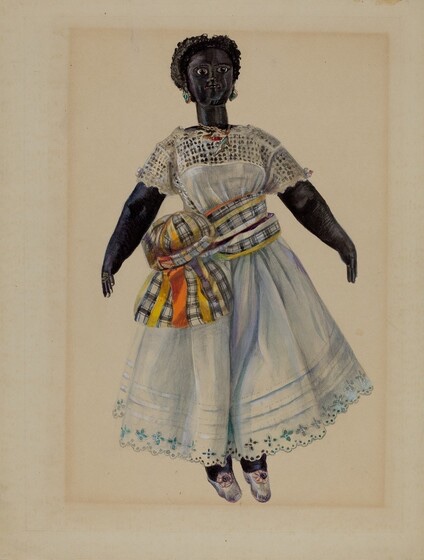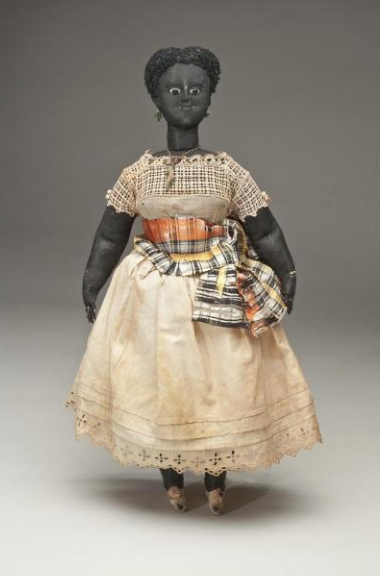Doll Paintings in American Design: A Window into Racial Ideologies
by Allison L. W. Robinson

Renee A. Monfalcone, Doorstop Doll, 1941. Watercolor and graphite on paper. Index of American Design, 1943.8.15613. Courtesy of the National Gallery of Art.
When I first laid eyes on the watercolor, the scarf wrapped tightly around her black satin head immediately caught my attention. My eyes danced between its tomato red hue, golden yellow starbursts, and prominent central knot. This simple piece of clothing gave the doll a contained femininity that also hinted at a figure at work rather than at rest. The bold apple red kerchief around her neck guided my eye downwards to study the rest of drawing.
The doll wore a long-sleeved and high-neck bodice, yellow and decorated with leaves flowing delicately from their lightly colored vines. Her shirt was cuffed at the wrist to add an elegant ruffle. The plain white apron appeared to sharply contrast with the charm of her other decorative touches at first glance.
Further observation, however, revealed that the artist used greys to create folds and shadows, giving movement to the garment. Splashes of red indicated damage and age. Blues hinted at light playing along its surfaces. This watercolor captured the passage of time in the life of this doll forever frozen on canvas, a moment of connection between the object and the artist.
My imagination overflowed with the research and interpretive possibilities of this doll. It could serve as a lens into so many things—blackness as femininity, blackness as labor, and blackness as enslavement—as portrayed by the Index of American Design.
This research trip focused on Chapter Two of my University of Chicago doctoral dissertation, which examines watercolors of dolls featured in the Index of American Design. Of the approximately 17,000 objects illustrated for The Index, 300 depict dolls. The location of only a few of these is known, including one at the New-York Historical Society. My dissertation chapter argues that portrayal, description, and exhibition of these doll paintings serve as a window into the racial ideologies of the 1930s as formed through a federal interpretation of early American material culture.
I spent the majority of my research trip at the National Gallery of Art. Every week I combed through watercolors of dolls. I learned during my research that The Index contained watercolors of dolls portraying white, black, and Native American figures. Viewing them in person gave me a deeper understanding of and appreciation for how artists reproduced the three-dimensional dolls in paint and ink. The paper caught every sketched line, color wash, and brush stroke that brought these dolls to life for the American public.
The National Gallery also held a rich assortment of documents related to the Index of American Design. Many, but not all, of the watercolors that I viewed included observation notes and data sheets about the individual dolls. These documents captured the impressions that the artists had of each doll at the time of its painting. This has since pushed me to consider how the artists acted as mediators between the Americana and the general public, translating the doll and the racial ideologies that it materialized at the time of its production into a twentieth-century work of art.
I am grateful to the Decorative Arts Trust for facilitating my summer research in Washington, D.C., which was foundational for my dissertation. The watercolors and documents that I observed prompted me to explore how the dolls served as tools to teach children about race and nationalism during the Great Depression and World War II. I will continue my research on the Index of American design and other WPA doll-making programs as a Smithsonian Institution Predoctoral Fellow starting this fall.
The Decorative Arts Trusts offers grants and scholarships for young researchers as part of the Emerging Scholars Program. To support emerging scholars, please consider becoming a member of the Trust.
About The Decorative Arts Trust Bulletin
Formerly known as the "blog,” the Bulletin features new research and scholarship, travelogues, book reviews, and museum and gallery exhibitions. The Bulletin complements The Magazine of the Decorative Arts Trust, our biannual members publication.











